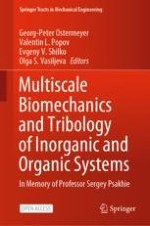This open access book gathers authoritative contributions concerning multiscale problems in biomechanics, geomechanics, materials science and tribology. It is written in memory of Sergey Grigorievich Psakhie to feature various aspects of his multifaceted research interests, ranging from theoretical physics, computer modeling of materials and material characterization at the atomic scale, to applications in space industry, medicine and geotectonics, and including organizational, psychological and philosophical aspects of scientific research and teaching as well. This book covers new advances relating to orthopedic implants, concerning the physiological, tribological and materials aspects of their behavior; medical and geological applications of permeable fluid-saturated materials; earthquake dynamics together with aspects relating to their managed and gentle release; lubrication, wear and material transfer in natural and artificial joints; material research in manufacturing processes; hard-soft matter interaction, including adhesive and capillary effects; using nanostructures for influencing living cells and for cancer treatment; manufacturing of surfaces with desired properties; self-organization of hierarchical structures during plastic deformation and thermal treatment; mechanics of composites and coatings; and many more. Covering established knowledge as well as new models and methods, this book provides readers with a comprehensive overview of the field, yet also with extensive details on each single topic.
